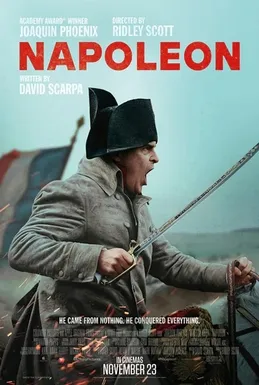Historical accuracy of Napoleon

Historical accuracy of Napoleon

Characters
Napoleon Bonaparte
Napoleon was a historical figure, but the film's portrayal by Joaquin Phoenix presents a specific interpretation emphasizing awkwardness and dependence on Josephine, debated by historians. Many actions and character traits shown are inaccurate or lack context.
Joséphine de Beauharnais
Joséphine was Napoleon's wife, but the film simplifies her character, exaggerates her overt sexuality/control over Napoleon, and misrepresents her age relative to him initially. Her political astuteness is downplayed.
Arthur Wellesley (Wellington)
Wellington was Napoleon's adversary at Waterloo. His portrayal is brief but generally reflects his historical role as the opposing commander.
Tsar Alexander I
Alexander I was the Tsar of Russia. The film depicts his meetings with Napoleon and role during the French invasion of Russia.
Marie Louise
Marie Louise married Napoleon and bore him an heir. Her portrayal is brief and functional to the plot point of Napoleon needing a son.
Paul Barras
Barras was a key figure in the Directory. The film depicts his political role and relationship with Joséphine, though perhaps emphasizing his decadence.
More characters
Talleyrand
Talleyrand was a major political survivor and diplomat. The film portrays his opportunistic nature but simplifies his complex career.
Armand de Caulaincourt
Caulaincourt served Napoleon closely, especially during the Russian campaign. His portrayal as a concerned advisor aligns with his known role.
Letizia Bonaparte
Letizia was Napoleon's mother. Her appearances are brief and generally align with her historical presence.
Robespierre
Shown briefly in the context of the Terror, representing the preceding phase of the Revolution before Napoleon's rise.
Marie Antoinette
Shown being taken to the guillotine, setting the historical context of the Revolution's violence.
Francis I
Francis I was the Emperor of Austria and Marie Louise's father. His appearances relate to diplomacy and the marriage alliance.
Story
Napoleon witnesses Marie Antoinette's execution
Napoleon was not present at her execution; he was commanding troops at the Siege of Toulon hundreds of miles away at the time.
Napoleon leads cavalry charge at Toulon
Napoleon was an artillery commander at Toulon, noted for his strategic planning, not for leading cavalry charges. His horse was shot from under him, but not during a charge he personally led.
Napoleon fires cannons on Royalist mob (13 Vendémiaire)
Napoleon did command the forces that used cannon fire ("whiff of grapeshot") to suppress the Royalist uprising in Paris in 1795, crucial for his rise.
Meeting Joséphine / Relationship dynamic
Napoleon met and married Joséphine. However, the film misrepresents their age difference (she was 6 years older, not implied younger/same age), simplifies their complex dynamic, and fabricates scenes like the slap.
Egyptian Campaign (firing cannons at pyramids)
Napoleon invaded Egypt, but there's no evidence he ordered cannons fired at the Pyramids of Giza. The Battle of the Pyramids was fought miles away from them.
Coup of 18 Brumaire
Napoleon did seize power in this coup. The film depicts the chaos but simplifies the political maneuvering involved.
Napoleon crowns himself Emperor
Napoleon took the crown from the Pope and placed it on his own head during his coronation ceremony in 1804, accurately depicted as a symbol of his self-made authority.
Battle of Austerlitz (luring enemy onto ice)
While some retreating soldiers drowned falling through broken ice, Napoleon did not deliberately lure large parts of the enemy army onto ice to destroy them with cannon fire as depicted. This is a myth exaggerated by Napoleon himself.
Invasion of Russia (Borodino, Moscow burning, retreat)
Key events occurred (brutal Battle of Borodino, Moscow found abandoned/burning, disastrous winter retreat). However, battle tactics and specific events are simplified or dramatized.
Divorce from Joséphine / Slapping scene
Napoleon divorced Joséphine because she couldn't provide an heir (True). The public slapping scene during the divorce proceedings is a complete fabrication (False).
Marriage to Marie Louise
Napoleon married Austrian Archduchess Marie Louise to secure an alliance and an heir.
Exile to Elba and return (Hundred Days)
Napoleon was exiled to Elba, escaped, and returned to power in France for the period known as the Hundred Days.
Battle of Waterloo depiction
The battle occurred and Napoleon lost. However, the film's portrayal of tactics, Napoleon's direct involvement/command style, and specific incidents are often inaccurate or overly simplified.
Final exile to Saint Helena and death
Napoleon was exiled to Saint Helena after Waterloo, where he remained until his death in 1821.
Napoleon's battlefield presence/command style
The film repeatedly shows Napoleon personally leading charges or fighting in the front lines, contrary to historical accounts where he commanded strategically from the rear.
Setting
Revolutionary Paris / Reign of Terror
The film visually captures the chaotic and violent atmosphere of Paris during the later stages of the French Revolution.
Siege of Toulon depiction
The setting visually represents a pre-industrial siege, though the specific tactical layout and actions shown are inaccurate.
Egyptian campaign setting
The brief scenes effectively use visuals (pyramids, desert) to establish the Egyptian setting, even if the actions depicted there are inaccurate.
Napoleonic Battlefields (Austerlitz, Waterloo, etc.)
Visually impressive recreations of large-scale Napoleonic battles, capturing the scale and general look of warfare (formations, smoke), despite inaccuracies in specific tactics shown.
French Imperial Palaces / Settings
Locations like the Tuileries Palace, Malmaison, and Notre Dame (for the coronation) are sumptuously recreated, reflecting the grandeur of the Napoleonic era.
Costumes (Military and Civilian)
The costume design for both military uniforms (French, British, Russian, Austrian) and civilian attire of the Directory and Empire periods appears detailed and historically informed.
Military Equipment (Muskets, Cannons, etc.)
Weapons, artillery pieces, and cavalry equipment appear generally accurate for the period, contributing to the visual authenticity of battle scenes.
Exile locations (Elba, Saint Helena)
The film provides a visual sense of the island exile locations, though focusing more on Napoleon's state of mind than detailed environmental accuracy.
Overall late 18th / early 19th Century European Visuals
The film excels at creating a visually rich and immersive representation of the Napoleonic era across various European locations.
